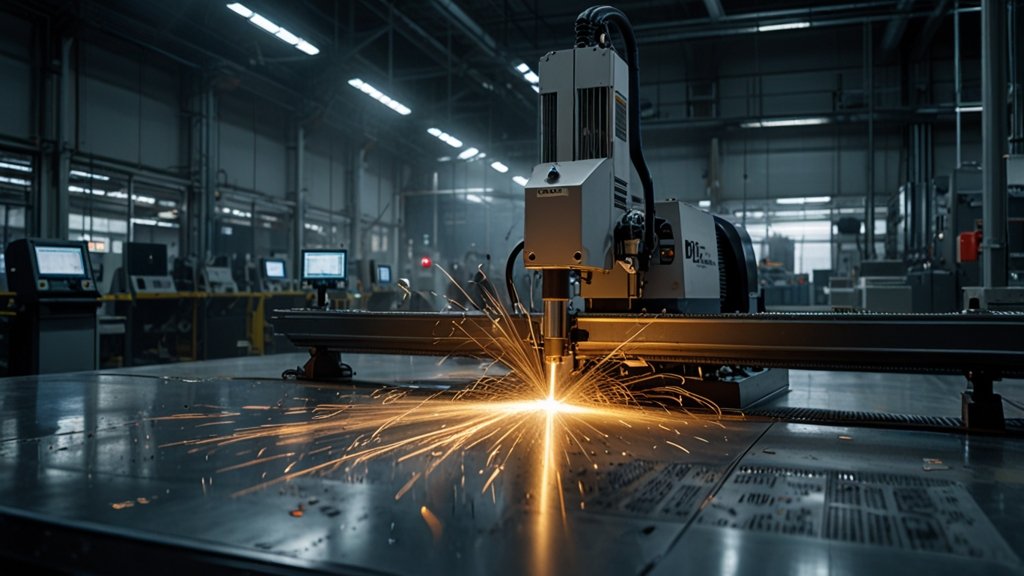Picture a sculptor transforming a block of marble into a masterpiece—only instead of a chisel, they wield a beam of light so intense it slices through titanium like warm butter. This isn’t fantasy; it’s today’s reality in factories worldwide, where cutting machines orchestrate feats of precision human hands could never achieve alone.
These technological marvels—whether mechanical, thermal, or abrasive—are the unsung heroes behind everything from aerospace turbines to the smartphone in your pocket. They shape our world with microscopic accuracy, turning raw materials into intricate components. But how do you choose the right one? And what makes them indispensable to industries racing toward innovation? Buckle up as we dissect the cutting edge of industrial evolution.
The Three Titans of Cutting: Mechanical, Thermal & Abrasive Explained
Cutting machines don’t just “cut”—they sculpt, vaporize, and erode with purpose. Each method caters to unique materials, tolerances, and efficiencies. Here’s how they stack up:
🛠️ Mechanical Cutting: The Muscle Behind Repetition
Think: CNC-controlled saws, mills, and punches
- How it works: Physical blades or bits shear material through force.
- Best for: Metals, plastics, wood—where uniformity matters.
- Real-world hero: Tesla’s Gigafactories use CNC milling for battery casings, ensuring every unit fits perfectly.
🔥 Thermal Cutting: Where Heat Meets Precision
Think: Lasers and plasma torches
- How it works: Concentrated energy (light/electric arcs) melts or vaporizes material.
- Best for: Complex contours in steel, aluminum, or composites.
- Game-changer: SpaceX uses plasma cutters to craft lightweight rocket parts, trimming fuel costs by 20%.
💧 Abrasive Cutting: The Cold, Versatile Destroyer
Think: Waterjets garnished with gritty particles
- How it works: High-pressure water + abrasives (like garnet) erode material layer by layer.
- Best for: Sensitive materials (glass, stone, foam) where heat warping is unacceptable.
- Sustainability win: Leaves no toxic residue—Philips uses it for eco-friendly medical device production.
Also Read: i square – lenovo ex: Where Hardware Genius Meets AI Vision to Reshape Computing
Cutting Machine Comparison: Choosing Your Champion
When to deploy each technology? This table breaks it down:
| Method | Precision | Speed | Material Flexibility | Ideal Use Case |
|---|---|---|---|---|
| Mechanical | ±0.1 mm | ⚡⚡⚡⚡ | Metals, plastics, wood | High-volume automotive parts |
| Laser | ±0.05 mm | ⚡⚡⚡⚡⚡ | Metals, fabrics, acrylic | Intricate jewelry or electronics |
| Plasma | ±0.2 mm | ⚡⚡⚡⚡ | Conductive metals only | Shipbuilding, structural steel |
| Waterjet | ±0.13 mm | ⚡⚡⚡ | Everything (even Kevlar) | Aerospace composites, stone art |
Beyond the Factory: Unexpected Cutting Machine Innovations
Cutting tech isn’t confined to industrial hubs. It’s reshaping creativity and sustainability:
- Fashion Revolution: Adidas uses laser cutters to craft sneaker uppers from recycled plastic, reducing waste by 35%.
- Food Tech: Waterjets slice cakes and sushi rolls with pixel-perfect accuracy—no more jagged edges!
- Artistry Unleashed: Sculptor Janet Echelman creates colossal waterfront installations from waterjet-cut netting.
Your Cutting Machine Buyer’s Guide: 5 Non-Negotiables
Choosing the right tool? Avoid costly mistakes with these filters:
- Material Matters
- Lasers struggle with reflective metals (copper, brass); waterjets handle them easily.
- Pro Tip: Test a sample first—suppliers often offer free trials.
- Tolerance Tango
Need ±0.1 mm accuracy? Lasers win. For ±1 mm? Plasma suffices. - Operating Costs Exposed
- Waterjets consume abrasives + water ($$).
- Lasers need gas + lenses ($$$).
- Smart Move: Calculate cost-per-cut, not just sticker price.
- Space & Safety
Plasma cutters demand ventilation; waterjets need drainage. Got a small shop? Desktop lasers (like Glowforge) fit in garages. - Future-Proofing
Opt for IoT-enabled machines (Trumpf, Mazak brands) that predict maintenance needs via AI.
Tomorrow’s Cutting Edge: 3 Trends to Watch
- AI-Powered Precision: Machines that self-adjust for blade wear in real-time (no human tweaks needed).
- Green Cutting: Solar-powered lasers and recyclable abrasives slashing carbon footprints.
- Hybrid Systems: Waterjet + laser combos for “cut-and-weld” in one pass—Boeing is already testing prototypes.
Key Takeaways: Cutting Through the Noise
- For precision + speed: Laser cutting dominates.
- For versatility + eco-friendliness: Waterjet is king.
- For bulk metal shaping: Plasma or mechanical wins on cost.
Ready to dive deeper? Start with these steps:
- Audit your materials (type, thickness, sensitivity).
- Calculate ROI—include energy, labor, and waste costs.
- Pilot a project—lease before buying.
You May Also Read: Why .ydesi is Revolutionizing Online Identity for South Asian Innovators
FAQs
Can a cutting machine handle both metal and wood?
Absolutely! Waterjets cut both effortlessly. Lasers work too, but require power adjustments between materials.
How thin can a laser cutter slice?
Fiber lasers achieve 0.01 mm cuts—thinner than a human hair—in foils or medical stents.
Are DIY desktop cutters worth it?
For prototypes/small batches, yes. Glowforge and Boss Laser offer pro-grade results under $10K.
What safety gear is essential?
Plasma/lasers demand ISO-certified goggles; waterjets require ear protection (120 dB noise!).
How long do cutting machines last?
10–15 years with maintenance. Lubricate mechanical parts monthly; replace laser lenses yearly.
Can waterjets cut diamonds?
Ironically, no—diamonds deflect abrasives. Lasers or wire EDM handle ultra-hard materials.
What’s the biggest cost-saving hack?
Nesting software (like SigmaNEST) arranges parts to minimize material waste—saving up to 20% per sheet.










